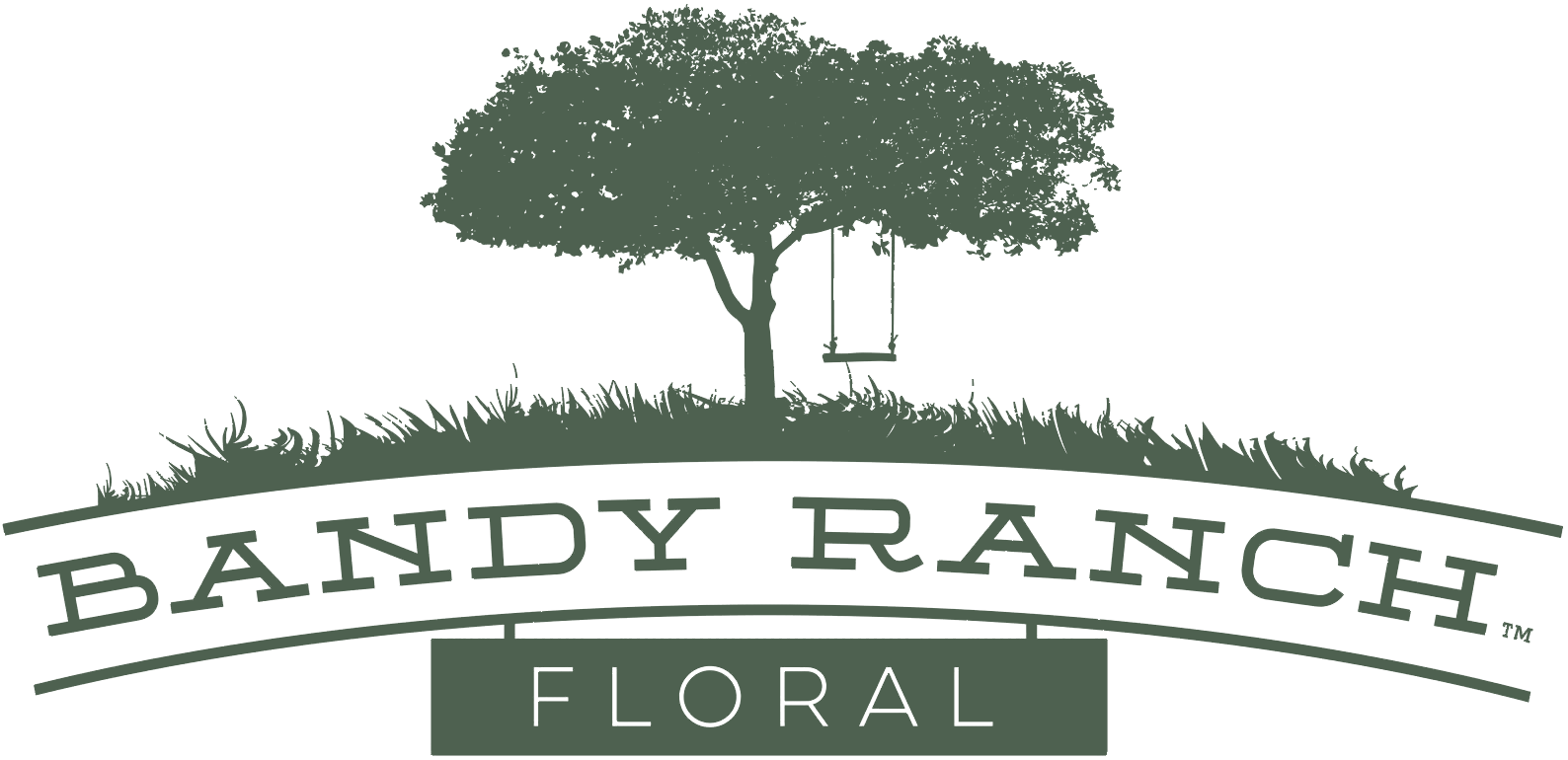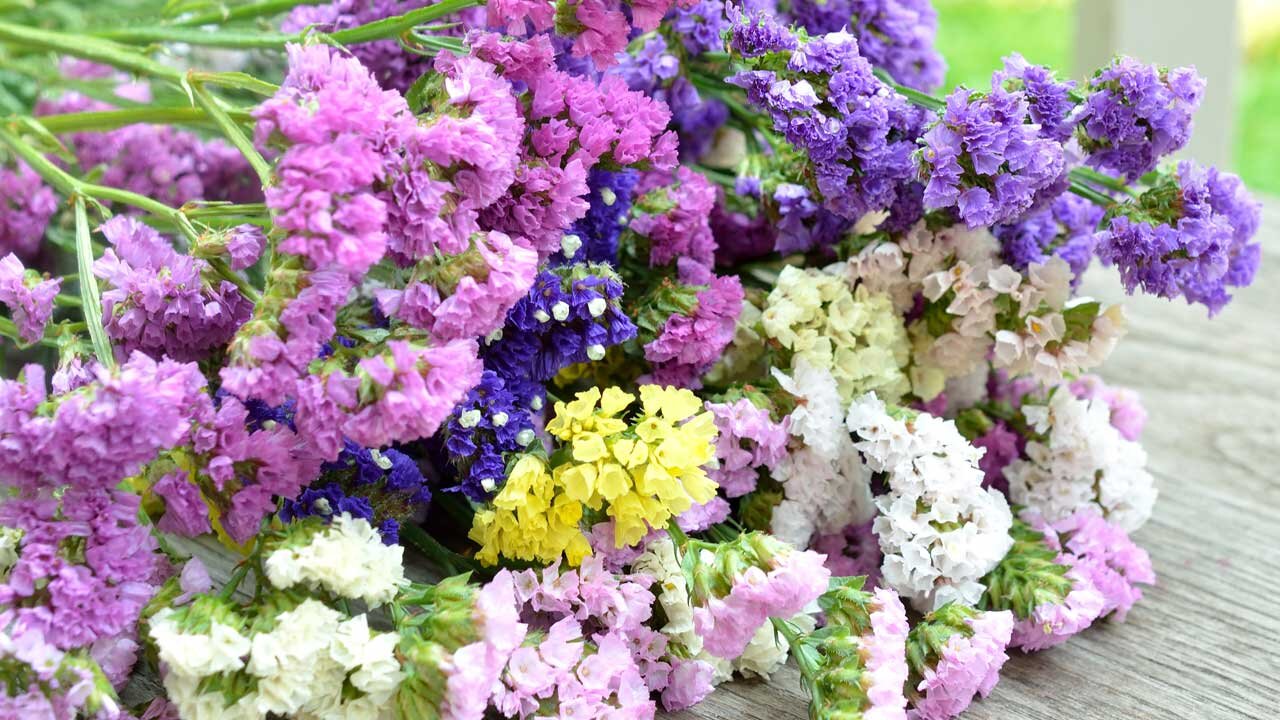

Flowers

WAXFLOWER (Chamelaucim)
Native to: Western Australia
Symbolizes: happiness in marriage
Form: filler
Fun Fact: The genus was first defined by French botanist René Louiche Desfontaines in 1819, and is related to leptospermum, eucalyptus and myrtle.
Purple Pride
Available December – March
Hybrid Bridal White
Available December – March
Sweet Sixteen
Available April – May
Julia
Available April – May

DIANTHUS (Caryophyllaceae)
Native to: Europe and Asia
Etymology: Greek words dios (God) and anthos (flower)
Symbolizes: admiration, passion, affection, gratitude
Form: filler
Fun Fact: The legend that explains the name is that Diana the Goddess came upon the shepherd boy and took a liking to him. But the boy, for some reason, turned her down. Diana ripped out his eyes and threw them to the ground where they sprouted into the Dianthus flower.
Cherry
Available November – August
Deep Purple
Available November – August

MARIGOLD (Tagetes)
Native to: South America
Etymology: Derives from the name of the Etruscan Tages, born from the plowing of the earth.
Symbolizes: passion and even creativity
Form: mass
Fun Fact: Originally called Mary's Gold, the marigold was named after the mother of Jesus, the Virgin Mary.
African
Available Summer – Autumn
French
Available Summer – Autumn

PROTEA (Protea)
Native to: South Africa
Etymology: Named after Proteus, son of Poseidon, who was known for change and transformation.
Symbolizes: diversity and courage
Form: mass
Fun Fact: Dating back approximately 300 million years, proteas are considered to be among the oldest families of flowering plants on the planet.
Pink Ice
Available August – January
Brenda
Available November – March
Susara
Available November – March
Pink Mink
Available November – March
Red Mink
Available November – March

PIN CUSHION PROTEA
Flame Giant
Available March – June
High Gold
Available November – March
Red Fire
Available November – March
Spider
Available November – March
Scarlet Ribbon
Available November – March
Tango Hybrid
Available November – March

SUNFLOWER (Helianthus annuus)
Native to: North America
Etymology: Greek words helios (sun) and anthos (flower)
Symbolizes: adoration, loyalty and longevity
Form: mass
Fun Fact: Young sunflowers track the sun, also referred to as heliotropism. When sunflowers reach maturity, their internal clocks start slowing down until they finish the heliotropism behavior completely.
Panache
Available March – September
Yellow
Available March – November
OTHER VARIETALS
Bells of Ireland
(Moluccella laevis)
Available year-round
Native to: Western Asia
Etymology: Moluccella gets its name from the Indonesian Molucca Islands, which were once mistakenly thought to be the flower's native land.
Symbolizes: good luck and fortune
Form: line flower
Fun Fact: Green is a color of good luck. As a symbol of prosperity, it is often the flower of choice during special events like St. Patrick's Day as well as during wedding ceremonies.
Boronia
(Boronia Heterophylla)
Available March – April
Native to: Western Australia
Etymology: Named after Francesco Borone, an 18th century Italian botanist.
Symbolizes: peace and comfort
Form: filler
Fun Fact: Red Boronia, despite it’s name, doesn’t actually come in red, it is a bright pink flower.
Craspedia (Pycnosorus globosus)
Available year-round
Native to: Australia
Etymology: Greek words pyknos (dense) and soros (heap). Globosus means spherical.
Form: mass
Fun Fact: It has a spherical head of up to 200 daisy-like "flowers.”
Eryngium (Eryngium alpinum)
Available year-round
Native to: Central and Southeastern Europe
Etymology: Ancient Greek name used by Theophrastus for a plant which grew in Greece (probably Eryngium campestre)
Symbolizes: independence, severity and attraction
Form: mass
Fun Fact: In Shakespeare's time the roots of Eryngium were known to be a strong aphrodisiac.
Eriostemon (Eriostemon australasius)
Available Winter – Spring
Native to: Eastern Austrailia
Etymology: Greek words erion (wool) and stemon (stamen)
Form: filler
Fun Fact: Eriostemon australasius was first cultivated in England in 1824.
Green Mist (Ammi visnaga)
Available year-round
Native to: North America
Etymology: Derived from the Greek word ammos (sand), and refers to the plant’s habitat.
Symbolizes: sanctuary
Form: filler
Fun Fact: Ammi visnaga, known as Khella, is one of the oldest herbs. It was originally cultivated by the ancient Egyptians who used it to treat many ailments, including urinary tract diseases. It was also used in the Middle Ages as a diuretic.
Kale (Brassica oleracea)
Available Summer – Autumn
Native to: Western Europe
Etymology: Derives from the French caboche (head).
Symbolizes: love and health
Form: focal
Fun Fact: This cabbage variety is still edible, but doesn’t taste much like traditional kale, cabbage and lettuce.
Kangaroo Paw (Anigozanthos)
Available Spring – Summer
Native to: Western Australia
Etymology: Derived from the Greek words anises (unequal) and anthos (flower).
Symbolizes: uniqueness and individuality
Form: line
Fun Fact: Each type of kangaroo paw plant is shaped so that its pollen goes on a different part of the bird's head. Because of this, the honeyeater birds can deliver pollen for each species of kangaroo paw to the exact species of kangaroo paw that needs it!
Larkspur (Delphinium bakeri)
Available year-round
Native to: Eastern North America
Symbolizes: Fickleness
Form: line
Fun Fact: In Transylvania, dried larkspur was placed in stables to keep witches from casting spells on the animals.
Pink Rice Flower
(Ozothamnus diosmifolius)
Available March – April
Native to: Australia
Etymology: Greek words helios (sun) and chryson (golden)
Symbolizes: everlasting and immortal
Form: Filler
Fun Fact: Prior to the mid-1980s, rice flower was extensively harvested from the wild for the cut flower trade. Following research on the species, commercial cultivation commenced in 1990 and by 1999 there were about 100 growers and exporters.
Pumpkin Tree (Solanum integrifolium)
Available Autumn
Native to: Southeast Asia
Form: mass
Fun Fact: Introduced as “Scarlet Chinese an ornamental curiosity” by Vanderbilt University in 1879, they are still grown to amuse guests and decorating homes.

Ranunculus (Ranunculaceae)
Available March – May
Native to: Asia
Etymology: Latin for little frog (refers to them being found near water)
Symbolizes: charm and attractiveness
Form: mass
Fun Fact: When it is cold, ranunculus forms its petals into a cup shape to collect solar energy to warm itself. Because of this blossoms cup-like shape, it collects sunlight directly to its center, where its reproductive organs lay. This gives a power boost to the whole system; ripening its stamens and boosting the pollen intake. Once the flower is pollinated, the solar heat will help with the development of the seeds.
Safflower (Carthamus tinctoris)
Available Summer – Autumn
Native to: Asia and Africa
Etymology: Carthamus is the latinised version of the Arabic word quartum which alludes to the color of the dye obtained from florets, and the modern Arabic name usfar is probably the origin of the English name "Safflower.”
Symbolizes: attractiveness to others
Form: filler
Fun Fact: Safflower is one of humanity's oldest crops. Chemical analysis of ancient Egyptian textiles dated to the Twelfth Dynasty identified dyes made from safflower, and garlands made from safflowers were found in the tomb of the pharaoh Tutankhamun.
Solidago (Solidago canadensis)
Available year-round
Native to: North America
Etymology: Latin words solido (to strengthen) and ago (make)
Symbolizes: sincerity, growth money, success, happiness, caution, and good fortune
Form: filler
Fun Fact: The stems and leaves of goldenrod have been dried and used in folk medicine. Its main use has been on the skin to treat wounds and as a diuretic.
Stock (Matthiola)
Available year-round
Native to: Southwestern Greece & Southern Albania
Etymology: Named after Pierandrea Matthiola, an Italian botanist and doctor who cultivated these flowers.
Symbolizes: love and lust
Form: line
Fun Fact: A member of the cabbage family, stock has edible flowers and green seed pods which share the family's snappy, radishy flavor.
Tissue Culture Statice (Limonium sinuatum)
Available year-round
Native to: Central Asia
Etymology: Greek word limonium (meadow)
Symbolizes: lasting beauty and success in life
Form: filler
Information on this page is based on research conducted in our nursery library and from online sources.





